Sand injectites are present in deepwater deposits across the globe, and understanding their attributes is necessary to successful E&P in sand injectite provinces.
Mads Huuse, University of Aberdeen, UK
Sandstone intrusions, or sand injectites, are the natural product of syn- or post-depositional remobilization and injection of sand into surrounding strata due to factors such as overpressure, hydrocarbon migration, diagenesis and seismicity.1-3 The natural processes of sand remobilization and injection and their products in the rock record (sandstone intrusions or sand injectites) should not be confused with any process that may occur or be induced during drilling. Sandstone intrusion occurrence has been discussed over the last two centuries, but they have only recently come to the attention of the petroleum industry due to their importance in the prolific Lower Tertiary play in the North Sea Basin.2,4-8
Their importance in the North Sea, an increasing interest in understanding fluid migration and a possible link between the intrusions and seismicity or even meteorite impacts has sparked a surge in the number of examples reported.9,10 An excellent range of recent studies of large-scale sand injectite complexes relevant to hydrocarbon exploration was recently captured by Hurst and Cartwright.11
This article discusses the occurrence, morphology and effects of sandstone intrusions on scales relevant to hydrocarbon exploration and production. Less emphasis is given to the origin of the intrusions, as this is still subject to debate due to an incomplete understanding of the processes involved in their formation.12 Illustrations are drawn from selected outcrop examples from NE Scotland, California and Patagonia while subsurface examples are all from the North Sea.
OCCURRENCE OF SANDSTONE INTRUSION RESERVOIRS
Reservoir-scale sandstone intrusions are likely to occur across all continents and in all sedimentary environments, but some environments are more prone to large-scale intrusions than others as large-scale intrusions (106-109 m3) seem to be far more common in deepwater than in any other sedimentary environment, Fig. 1. This is likely due to the prevalence of well-sorted, poorly consolidated sands and the low permeability of encasing mudstones, as well as the presence of underlying mature source rocks in deepwater environments.
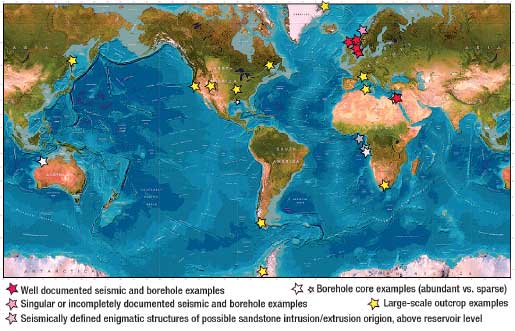 |
|
Fig. 1. Worldwide occurrence of selected large-scale sandstone intrusion complexes graded after their type and quality of documentation. Stratigraphic ages include Ordovician, Permian, Jurassic, Cretaceous, Paleogene and Neogene.
|
|
While sandstone intrusion occurrence and their impact in some deepwater provinces (Cretaceous-Eocene and Miocene onshore California and North Sea Tertiary) are well documented, other provinces are largely undocumented in the published literature, including offshore Brazil, Gulf of Mexico, Nile Delta, West Africa and the northwest shelf of Australia, although many of these have yielded good examples of core-scale sand injectites. Given the long delay from their discovery to widespread recognition in the North Sea (the first North Sea sandstone dike discovered 1969,8 but sand injectites have only been widely recognized in the last decade), it may be that the full impact of sand injectites on exploration and production in frontier deepwater provinces will only be fully realized over the next decade. Recognition of seismic-scale intrusions may require re-processing of seismic data to image the steep dips associated with the intrusions, but perhaps more importantly, a revised mindset when interpreting deepwater core, wireline and seismic data and placing these in a reservoir-seal framework.
Experience shows that, in some cases, massive sands, debrites and slump deposits may all be reinterpreted in terms of an origin linked with sand remobilization and injection, with implications for reservoir properties such as porosity and permeability, architecture, connectivity, oil-in-place and recovery factors as well as top-seal integrity and migration pathways.1,2,5,6,13
OUTCROP AND SUBSURFACE DATA
Because of their importance in hydrocarbon systems in California and the North Sea, large-scale sandstone intrusions are most well documented from these regions. The images of outcrops provide examples of small- to large-scale dikes and sills, and complex intrusive geometries over a spectrum of intrusive grain sizes from the most common fine- to medium-grained sand (Figs. 2a-c) to mud-matrix cobble conglomerate, Figs. 2d-e.14 At outcrop, intrusions can be seen to crosscut over a km of stratigraphic section, can be tens of meters thick and extend over 10 km for individual intrusions and 100-10,000 km2 for intrusion complexes. Figures 2b-d indicate the large-scale of intrusion seen in these outcrops with dikes cutting upward through hundreds of meters of host strata with obvious implications for reservoir and migration of hydrocarbons.
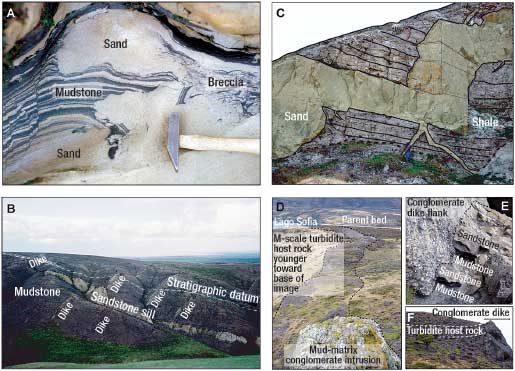 |
|
Fig. 2. Outcrop examples of sand (a-c) and conglomerate (d-f) intrusions from (a) Jurassic of NE Scotland, (b) Eocene of Central California, (c) Cretaceous-Paleocene of Central California (total stratigraphic extent of injectites > 1 km), and (d-f) Cretaceous of Southern Chilean Patagonia.
|
|
For recognition of sandstone intrusions in borehole core, it should be noted that structures like laminae and mud-clast breccia commonly occur in injected sandstones, making it difficult to discern between depositional sand bodies and injected sand bodies based on sedimentary structures alone, Fig. 3. It is thus important to recognize the associations of facies and their contacts in order to determine an injected or depositional origin.6,7 On a seismic scale, large-scale sandstone intrusions, many of which were previously interpreted as enigmatic or ratty sands, are now commonly recognized by their discordant nature, isolated occurrence in unrelated depositional settings and by their association with intrusions recognized in borehole core or wireline logs, such as dip-meter, modelled resistivity logs or image logs, Fig. 4.
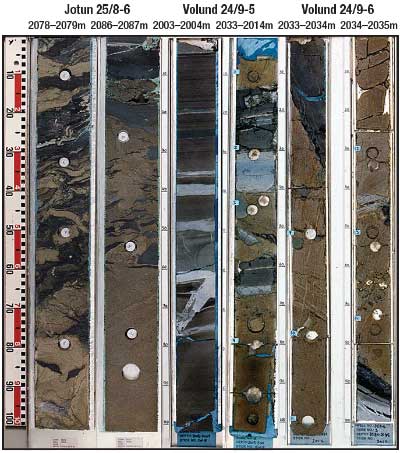 |
|
Fig. 3. North Sea core examples of injectite deposits ranging from (from left to right) ‘soft’, pervasive intrusions that may indicate early syn-depositional deformation or shallow-subsurface emplacement of sand; mudstone-clast breccia suggestive of brittle and ductile behavior of the mudstones during fracturing and subsequent sand emplacement; sharp Z-shaped dike (cemented) indicating brittle failure of the host mudstones; bedding parallel contacts with some irregularities suggesting that the sandstones are sills rather than depositional beds; discordant upper and lower margins to a 1.7-m thick sandstone containing dm-scale angular mudstone clasts interpreted as a sandstone dike. Examples drawn from sand injectite fields Jotun (25/8-6) and Volund (24/9-5 and 24/9-6, Fig. 6). Courtesy of the Norwegian Petroleum Directorate.
|
|
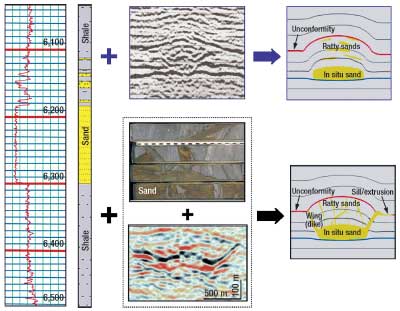 |
|
Fig. 4. Conventional interpretation of an isolated sandbody with overlying ‘ratty’ sandstones based on well logs and low-fidelity seismic data, and the alternative interpretation using core data in combination with high-fidelity 3D seismic data.
|
|
However, seismic recognition of such structures is often hampered by inadequate acquisition and processing, although it can be improved by 3D seismic imaging and processing that allows for the inclusion of steep dips, such as wide-aperture pre-stack migration. As for conventional reservoirs, seismic resolution and acoustic impedance contrast with encasing non-reservoir rocks is also of critical importance for their seismic imaging.3,5
Subsurface case studies with adequate documentation, by their nature, largely involve proven or suspected oil reservoirs, although water-bearing sandstone intrusion complexes also have been discovered that may help understand their oil-filled equivalents.10-13,15 The examples given here are meant to highlight some of the main points, including the scale and widespread occurrence within the North Sea Tertiary deposits as imaged by 3D seismic data, Figs. 5-7. The literature and the examples given form the basis for an overview of the implications of sand injectites for hydrocarbon exploration and production, as exemplified by the production drilling schematics of conventional mounded sand bodies and sand injectite fields, Figs. 8a-b.
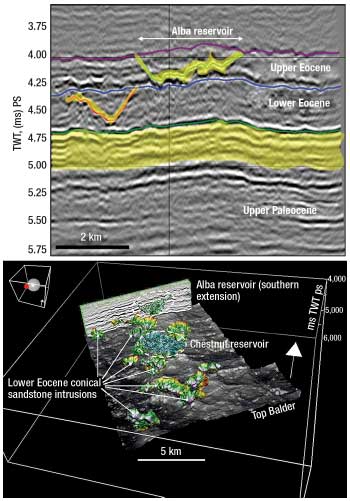 |
|
Fig. 5. Seismic cross section and 3D visualization from the Alba/Chestnut fairway of the Outer Moray Firth (UK 22/2), showing conical intrusions in the lower Eocene and remobilized and injected sandstones in the middle Eocene above a broad anticline in the underlying Forties aquifer.13 Courtesy of WesternGeco.
|
|
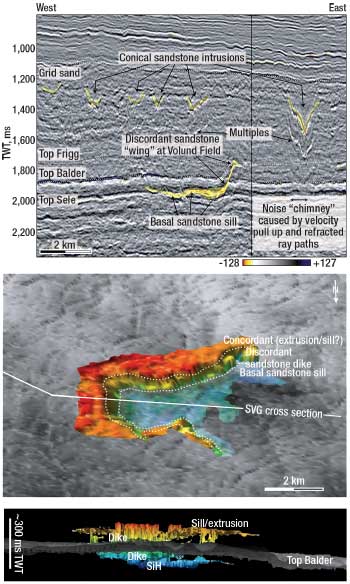 |
|
Fig. 6. Seismic cross section from the Volund area (N 24/9-5, -6, -7) of the South Viking Graben showing two main intrusion intervals (Lower Eocene swan shape and lower Middle Eocene V-shaped intrusions), and 3D visualization of the swan, revealing its overall saucer-shaped geometry and large extent. The saucer-shaped body is interpreted as completely injected in origin and hosts about 100 million bbls of light oil.3,7
|
|
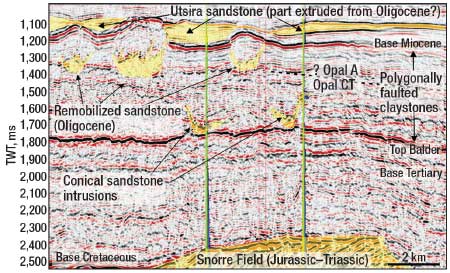 |
|
Fig. 7. Seismic cross section from the Snorre Field in the North Viking Graben (N 34/7) with interpretation of Eocene conical intrusions, remobilized Oligocene sandstones, and possibly part-extruded Utsira sandstones (Upper Miocene-Pliocene).12
|
|
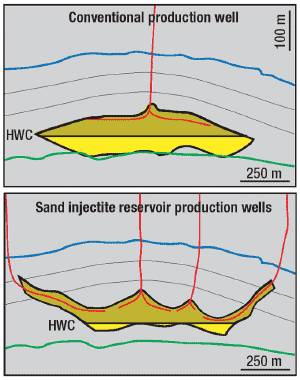 |
|
Fig. 8. Production well scenarios for conventional and remobilized and/or injected reservoir bodies.
|
|
IMPLICATIONS FOR E&P
Oil and gas production from sandstone injectite reservoirs is controlled by many of the same factors that control other reservoirs. However, a number of factors are particularly important, or even unique to sandstone intrusions, including reservoir occurrence and compartmentalization, reservoir rock and fluid properties, seal integrity, fluid migration, drilling risk and evidence for episodic fluid expulsion.
Large-scale intrusion occurrence is difficult to predict in frontier basins, unless distinctly discordant geometries or abnormal, localized thickness anomalies are seen in seismic data. The abrupt and non-depositional nature of sand injectites suggests that it makes little sense to predict sandstone intrusion thickness or distribution based on interpolation from well data, but careful analysis of 3D seismic data makes pre-drill detection possible.
Large-scale intrusions are common in deepwater where up to 106-109 m3 intrusions may be emplaced up to 1-2 km above, or adjacent to, their parent sand body, Fig. 6. Large-scale intrusions may occur within hemipelagic mudstones with no depositional sandstones or within heterolithic successions, making their interpretation ambiguous. Such sands have been described as terminal lobes, often assumed fed by mud-plugged, “invisible” channels. However, many of these show all the characteristics of fully intruded bodies (increased thickness of the host interval, jack-up and onlap of the overburden, discordant anomalies, rugged top and base surfaces) and are now interpreted as large-scale, saucer-shaped sandstone intrusions, Figs. 5-7.3,13
Smaller-scale intrusions may occur within slump deposits and between individual turbidites, suggesting a syn-depositional or early post-depositional origin, or as intrusions emplaced near the paleo-seafloor from a deeper source.7 Such intrusions are usually below seismic resolution, although a composite reflection may be seen, particularly if the injectites are cemented or gas-bearing.3 Sub-seismic scale intrusions may be extremely difficult to detect and predict away from wellbores, but can be significant for inter- and intra-reservoir connectivity. Difficulties aside, several North Sea operators are now actively pursuing sand injectite reservoirs as part of their exploration portfolio, and the first published account of a fully injected reservoir to be targeted by an exploration well reports 40 million bbl of recoverable light crude.7
Many injected sandstone reservoirs are encased in polygonally faulted claystones,2,3 and any compartmentalization from the injection process can be enhanced by post-injection faulting due to de-watering of the encasing mudstones. Multiphase injection, involving either single or multiple-source sand bodies, may also occur, resulting in crosscutting relations between intrusions and between intrusions and depositional sand bodies. Compartmentalization may thus be present due to a combination of individual intrusion geometries, faulting and multi-phase intrusion, resulting in very complex geometries. In some cases, the intrusion carapace overlying a massive parent sand body may crosscut hundreds of meters of overburden strata, displacing hydrocarbons into the intrusion carapace, which may be thought of as an intricate network of intrusions of all inclinations and orientations that is difficult to fully characterize based on well or seismic data.3,4,8
If the Hydrocarbon-Water Contact (HWC) occurs within the intrusive carapace, early determination of this relationship will be required for successful development, and also a development and production strategy that takes into account a very heterogeneous reservoir section in terms of net to gross and tortuosity of fluid movements, making completion and efficient drainage difficult.
Deviated production well completion is possible where large-scale, seismically detectable intrusions are above the HWC (Fig. 8),5 though seismic imaging will be affected by tuning effects due to upward thinning and lateral variations in the thickness of the intrusions.3,5 Where the HWC is located within the lower massive sandstone, completion can occur in the massive sandstone, and where a gas cap is present, gas can be injected into the carapace and may help displace the oil downward into the massive sandstone. Water injectors may be drilled into the lower part of the reservoir, but this is often unnecessary due to good aquifer drive in injected sandstone reservoirs that are connected downward to their parent sand body.
Reservoir and fluid properties associated with sandstone intrusions often, but not exclusively, involve poorly-consolidated, fine- to medium-grained sandstones with excellent porosity and permeability ranges (30-40% and 1-10 Darcy, respectively). Sand injectite reservoirs often contain heavy, low API crude, although light crude- and gas-bearing injectite fields also occur. The combination of poorly-consolidated fine sands and heavy oil may result in sand production problems, as is the case for Eocene Alba Field of the UK Continental Shelf (UKCS), Fig. 5.5
However, given the generally high porosity and permeability, heavy crude production is possible from these reservoirs, provided a suitable development strategy in terms of well placement, completion design and production and injection rates are implemented from the beginning of field development.
Seal integrity assessments are complicated by the non-stratigraphic top reservoir surface associated with sand injectites, Figs. 4-6, 8. It is often difficult to define a consistent top reservoir pick in sand injectite reservoirs. However, once it is established that an intrusion complex is confined within a given stratigraphic interval, the immediately overlying deposits can be examined for their sealing qualities. Sandstone intrusion reservoirs are often in pressure communication, and the hydrocarbon buoyancy and pore pressure used in top-seal integrity studies should thus take the entire hydrocarbon column into account, not just the column encountered in a particular well. The definition of the effective top-seal can be difficult based on limited well data, such as data that do not easily disclose the highest intrusion level within the seal. However, if pressure measurements are available and carefully analyzed, the effective top-seal may be defined.
Hydrocarbon charge of sandstone intrusion reservoirs is often facilitated by their association with a regional underlying aquifer that may become the carrier for lateral migration from the hydrocarbon source. Provided the intrusions remain connected to their parent sand body, lateral migration would be intercepted wherever the migration route was intersected by an upward connected sandstone intrusion root, causing vertical leakage from the regional aquifer into numerous smaller, but vertically extensive, reservoir units, Fig. 5.13 Hydrocarbon migration through injectites may be inferred from constellations of aquifer, injectite and reservoir or from fluid inclusion and geochemical studies,9 both of which suggest that intrusions may have a long-lived history of fluid migration until they either are cemented or their connection to underlying or adjacent fluid sources is obstructed by structural or polygonal faulting. Complete cementation of injectites is extremely rare, but may occur, particularly for minor core-scale intrusions (e.g., Z-shaped intrusion, Fig. 3).
The non-stratigraphic, unpredictable occurrence of large-scale sand injectites and their significant volume make them unpleasant surprises for drillers who may intersect large, high-porosity sand bodies within polygonally faulted mudstone sequences that are often drilled using overbalanced mud. This may lead to severe mud losses or even complete loss of the well bore, highlighting the need for revised drilling practices in injectite provinces, such as the Eocene of the Outer Moray Firth. On the other hand, oil-bearing sand injectite reservoirs may be intersected fortuitously en route to deeper reservoir targets.
Unlike small-scale sandstone intrusions that are often used to infer ancient earthquakes in continental sequences, the km-scale sand injectites discovered in the North Sea are difficult to understand both in terms of driving and triggering mechanisms. However, their placement must have been associated with significant, catastrophic fluid evacuation to drive the upward and lateral sand injection against gravity and overburden forces. The stacked occurrence in parts of the North Sea suggests that the area has suffered numerous episodes of catastrophic fluid evacuation, most likely driven by both brine and hydrocarbon fluids and triggered by large-magnitude earthquakes or meteorite impacts.12
Common episodes include the end Paleocene, early Eocene (top Frigg), mid Eocene, end Eocene, and mid Miocene. The exact timing and correlation between injection events in different areas is still poorly constrained and subject to ongoing studies, which aim to compile evidence for timings of injection events, regional and local tectonic events, hydrocarbon migration, diagenesis, mudstone de-watering, sea-level change and even meteorite impacts to provide a fully integrated model for the genesis of the North Sea injectite province. Such a model will significantly improve our understanding of this “well known” basin and enable us to predict injectite occurrences and their impact on exploration and production elsewhere.
CONCLUSIONS
Sandstone intrusions occur in abundance in many sedimentary environments, but are particularly common in deepwater where they often have significant impact on E&P. Sand injectite reservoirs are an important part of the Paleogene deepwater play of the North Sea, but an increasing number of observations point to their importance in other hydrocarbon provinces around the world. The importance for E&P includes reservoir occurrence, architecture and flow properties, inter- and intra-reservoir connectivity, fluid migration and drilling hazards. Their effects are both good and bad, and knowledge of their manifestation in a particular play is essential to their efficient exploitation and mitigation.
Intrusion reservoirs are often highly porous with porosities in the 30-40% range and permeability in the 1-10 Darcy range. Sand production may be an issue if the reservoir fluid is heavy oil. The complex reservoir geometries cause challenges for seismic imaging, well planning and completion. The occurrence of sandstone intrusions at various scales tells a story of basin de-watering and hydrocarbon expulsion in episodic bursts as highly focused fluid and sediment injections and extrusions, triggered by seismicity and driven by fluid overpressure within the upper few km of the Earth’s crust. 
ACKNOWLEDGEMENTS
I am grateful to the numerous people who have interacted with me since I first entered the world of sand injectites in late 2000. I am particularly grateful to professors Joe Cartwright, Andrew Hurst and Davide Duranti for discussions and collaboration over the epast eight years. The Injected Sands Project Phase I (2000-2002) was sponsored by Chevron, Enterprise, Hydro, Statoil, Shell and TotalFinaElf. Numerous individuals at oil companies and in academia, and not least research students, have helped shape my view on the subject over the years and continue to do so.
LITERATURE CITED
1 Jenkins, O., “Sandstone dikes as conduits for oil migration through shales,” AAPG Bulletin, 14, 1930, pp. 411-421.
2 Lonergan, L., Lee, N., Johnson, H. D., Cartwright, J. A. and R. J. H. Jolly, “Remobilization and injection in deepwater depositional systems: implications for reservoir architecture and prediction,” in Weimer, P. et al., eds., Deepwater reservoirs of the World, GCSSEPM Foundation, 20th Annual Conference, Houston, 2000, pp. 515-532.
3 Huuse, M., Cartwright, J., Hurst, A. and N. Steinsland, “Seismic characterization of large-scale sandstone intrusions,” in Hurst, A. and J. Cartwright, eds., Sand Injectites: Implications for Hydrocarbon Exploration and Production, AAPG Memoir, 87, 2007, pp. 21-35.
4 Dixon, R. J. et al., “Sandstone diapirism and clastic intrusion in the Tertiary submarine fans of the Bruce-Beryl Embayment, Quadrant 9, UKCS,” in Hartley, A. J. and D. J. Prosser, eds., Characterization of deep-marine clastic systems, Geological Society, London, Special Publications, 94, 1995, pp. 77-94.
5 MacLeod, M. K, Hanson, R. A., Bell, C. R. and S. McHugo, “The Alba Field ocean bottom cable seismic survey: Impact on development,” The Leading Edge, 1999, pp. 1306-1312.
6 Duranti, D., Hurst, A., Bell, C. Groves, S. and R. Hanson, “Injected and remobilized sands from the Alba Field (Eocene, UKCS): core and wireline log characteristics,” Petroleum Geoscience, 8, 2002, pp. 99-107.
7 de Boer, W., Rawlinson, P. B. and A. Hurst, “Successful exploration of a sand injectite complex: Hamsun prospect, Norway Block 24/9,” in A. Hurst and J. Cartwright, eds., Sand injectites: Implications for hydrocarbon exploration and production, AAPG Memoir, 87, 2007, pp. 65-68.
8 Briedis, N. A., Bergslien, D., Hjellbak, A., Hill, R. E. and G. J. Moir, “Recognition criteria, significance to field performance, and reservoir modelling of sand injections in the Balder Field, North Sea,” in Hurst, A. and J. Cartwright, eds., Sand Injectites: Implications for Hydrocarbon Exploration and Production, AAPG Memoir, 87, 2007, pp. 91-102.
9 Jonk, R., Hurst, A., Duranti, D., Parnell, J., Mazzini, A. and A. E. Fallick, “Origin and timing of sand injection, petroleum migration, and diagenesis in Tertiary reservoirs, south Viking Graben, North Sea,” AAPG Bulletin, 89, No. 3, 2005, pp. 329-357.
10 Cartwright, J., Huuse, M. and A. Aplin, “Seal Bypass Systems,” AAPG Bulletin, 91, 2007, pp. 1141-1166.
11 Hurst, A. and J. Cartwright, eds., Sand injectites: Implications for hydrocarbon exploration and production, AAPG Memoir, 87, 2007.
12 Huuse, M. and M. Mickelson, “Eocene sandstone intrusions in the Tampen Spur area (Norwegian North Sea Quad 34) imaged by 3D seismic data,” Marine and Petroleum Geology, 21, 2002, pp. 141-155.
13 Huuse, M., Cartwright, J., Gras, R. and A. Hurst, “Km-scale sandstone intrusions in the Eocene of the Outer Moray Firth (UK North Sea): migration paths, reservoirs and potential drilling hazards,” in Doré, A. G. and B. Vining, eds., Petroleum Geology of NW Europe: Proceedings of the 6th Conference, Geological Society, London, 2005, pp. 1577-1594.
14 Hubbard, S. A., Romans, B. W. and S. A. Graham, “An outcrop example of large-scale conglomeratic intrusions sourced from deepwater channel deposits, Cerro Toro Formation, Magallanes Basin, Southern Chile,” in Hurst, A. and J. Cartwright, eds., Sand Injectites: Implications for Hydrocarbon Exploration and Production, AAPG Memoir, 87, 2007, pp. 199-207.
15 Hurst, A. et al. “Significance of large-scale sand injectites as long-term fluid conduits: evidence from seismic data,” Geofluids, 3, 2003, pp. 263-274.
|
THE AUTHOR
|
| |
Mads Huuse is a geophysics lecturer at the School of Geosciences, University of Aberdeen. He joined UoA in 2005 after earning a PhD in geology from the University of Aarhus and post docs at LDEO-Columbia, Aarhus, UoA and Cardiff. His research interests span the geological interpretation of reflection seismic data, applied to fluid flow phenomena (including sandstone intrusions), continental margin evolution, glaciogenic reservoirs and tectonics, and cool-water carbonates.
|
|
|










